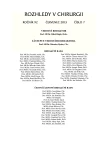Intraoperative CT navigation in spinal and pelvic surgery: initial experience
Authors:
V. Džupa 1,2; M. Krbec 2; R. Kadeřábek 3; R. Rusnák 1,4; P. Douša 2; J. Skála-Rosenbaum 2; F. Fridrich 2; V. Báča 1,5; R. Grill 1,6
Authors‘ workplace:
Centrum pro integrované studium pánve 3. LF UK, Praha, vedoucí lékař: Doc. MUDr. R. Grill, PhD.
1; Ortopedicko-traumatologická klinika 3. LF UK a FNKV, Praha, přednosta: Prof. MUDr. M. Krbec, CSc.
2; Radiodiagnostická klinika 3. LF UK a FNKV, Praha, přednosta: Doc. MUDr. V. Janík, CSc.
3; Neurochirurgická klinika, spondylochirurgické oddelenie Ústrednej vojenskej nemocnice SNP
FN Ružomberok, primár: MUDr. R. Rusnák, PhD.
4; Ústav anatomie 3. LF UK, Praha, přednosta: Doc. MUDr. P. Zach, CSc.
5; Urologická klinika 3. LF UK a FNKV, Praha, přednosta: Doc. MUDr. R. Grill, PhD.
6
Published in:
Rozhl. Chir., 2013, roč. 92, č. 7, s. 379-384.
Category:
Original articles
Overview
Introduction:
The authors describe their first experience with virtually navigated pelvic and spine screws based on perioperative CT navigation.
Material and methods:
From 22 October 2012 (launching the device) to 9 January 2013, a total of 15 CT-navigated pelvic and spine operations were performed in 14 patients. Nerve root compression, scoliosis, vertebral fracture and spondylodiscitis were the indications for spine procedures; B-type and C-type fractures according to the AO classification were the indications in pelvic surgical procedures. The preparation and the course of the procedures were in accordance with current standards and recommendations in all the cases. Perioperative navigation and subsequent examination of the screw trajectory were performed via O-arm imaging system (Medtronic Navigation, Louisville, Colorado) instead of the standard C-arm fluoroscopy.
Results:
A total of 73 screws were inserted (60 transpedicular screws into cervical, thoracic and lumbar vertebrae, 9 iliosacral screws into the first sacral vertebra and 4 pubic screws). Only one of the pubic screws (1.4% of all screws) was found malpositioned at the subsequent perioperative examination and was extracted immediately and replaced. Further complications were not observed and none of the procedures had to be converted into a standard fluoroscopy guided operation.
Conclusion:
A short but intensive experience with perioperative CT navigation allows us to state: 1. CT navigation shortens the operating time and minimalizes the risk of screw malposition in multiple screw spine procedures; 2. CT navigation improves the introduction of iliosacral and pubic screws in pelvic fixations; 3. there is virtually no radiation load to the staff using the CT navigation; 4. mastering this technique will allow a wider use of miniinvasive screw insertion in the pelvis and other regions where minimal dislocation will enable miniinvasive internal fixation.
Key words:
CT navigation – transpedicular screw – iliosacral screw – pubic screw
Sources
1. Kahler DM. Computer-assisted closed techniques of reduction and fixation, in: Tile M, Helfet DL, Kellam JE (Eds.). Fractures of the pelvis and acetabulum. Third edition. Philadelphia, Lippincott Williams & Wilkins 2003;604–615.
2. Kendoff D, Gardner MJ, Citak M, Kfuri M, Thumes B, Krettek C, Hüfner T. Value of 3D fluoroscopic imaging of acetabular fractures comparison to 2D fluoroscopy and CT imaging. Arch Orthop Trauma Surg 2008;128 : 599–605.
3. Mosheiff R, Khoury A, Weil Y, Liebergall M. First generation computerized fluoroscopic navigation in percutaneous pelvic surgery. J Orthop Trauma 2004;18 : 106–111.
4. Ochs BG, Gonser C, Shiozawa T, Badke A, Weise K, Rolauffs B, Stuby FM. Computer-assisted periacetabular screw placement: comparison of different fluoroscopy-based navigation procedures with conventional technique. Injury 2010;41 : 1297–1305.
5. Taller S, Lukáš R, Šrám J. Samostatné kanylované šrouby při stabilizaci zlomenin pánevního kruhu a acetabula. Acta Chir orthop Traum čech 2011;78 : 568–577.
6. Chmelová J, Pleva L. Perkutánní fixace zlomenin pánve pod CT kontrolou. Čes Radiol, 2002;1 : 16–20.
7. Taller S, Lukáš R, Šrám J, Beran J. 100 CT navigovaných operací pánve. Acta Chir orthop Traum čech, 2003;70 : 279–284.
8. Burch S, Karahalios D, Mobasser J-P, Potts E. Comparison of radiation exposure to the spine surgeon during pedicle screw placement using O-arm® System & StealthStation® Navigation vs. C-arm Standard Flouroscopy. Louisville, Medtronic 2010;1–5.
9. Pohlemann T, Regel G, Tscherne H. Klassifikation und Begriffsbestimmungen. In: Tscherne H, Pohlemann T (Eds.). Becken und Acetabulum. Berlin, Springer 1998;47–62.
10. Ebraheim NA, Rusin JJ, Coombs RJ, Jackson WT, Holiday B. Percutaneous computed tomography stabilization of pelvis fracture, preliminary report. J Orthop Trauma 1987;1 : 197–204.
11. Beran J, Taller S, Lukáš R, Bubeník J. Osteosyntézy SI skloubení a fraktur acetabula pod CT kontrolou. Čes Radiol 2001;5 : 303–307.
12. Frank M, Dědek T, Trlica J, Folvarský J. Perkutánní osteosyntéza předního pilíře acetabula: první zkušenosti. Acta Chir orthop Traum čech 2010;77 : 99–104.
13. Hong G, Cong-Feng L, Cheng-Fang H, Cang-Qing Z, Bing-Fang Z. Percutaneous screw fixation of acetabular fractures with 2D fluoroscopy-based computerized navigation. Arch Orthop Trauma Surg 2010;130 : 1177–1183.
14. Rommens PM. Is there a role for percutaneous pelvic and acetabular reconstruction? Injury 2007;38 : 463–477.
15. Zhang J, Weir V, Fajardo L, Lin J, Hsiung H, Ritenour ER. Dosimetric characterization of a cone-beam O-arm (TM) imaging systém. J X-ray Sci Technol 2009;17 : 305–317.
16. Patil S, Lindley EM, Burger EL, Yoshihara H, Patel VV. Pedicle screw placement with O-arm and stealth navigation. Orthopedics 2012; 35:e61–65.
17. Van de Kelft E, Vosta F, Van der Planken D, Schils F. A prospective multicenter registry on the accuracy of pedicle screw placement in the thoracic, lumbar, and sacral levels with the use of the O-arm imaging system and StealthStation Navigation. Spine (Phila Pa 1976) 2012;37,25:E1580–1587.
Labels
Surgery Orthopaedics Trauma surgeryArticle was published in
Perspectives in Surgery

2013 Issue 7
Most read in this issue
- Laparoscopic resection of the sigmoid colon for the diverticular disease
- Diverticular disease of the large bowel – surgical treatment
- Diverticular disease of the large bowel – imaging methods
- The staple line in sleeve gastrectomy
